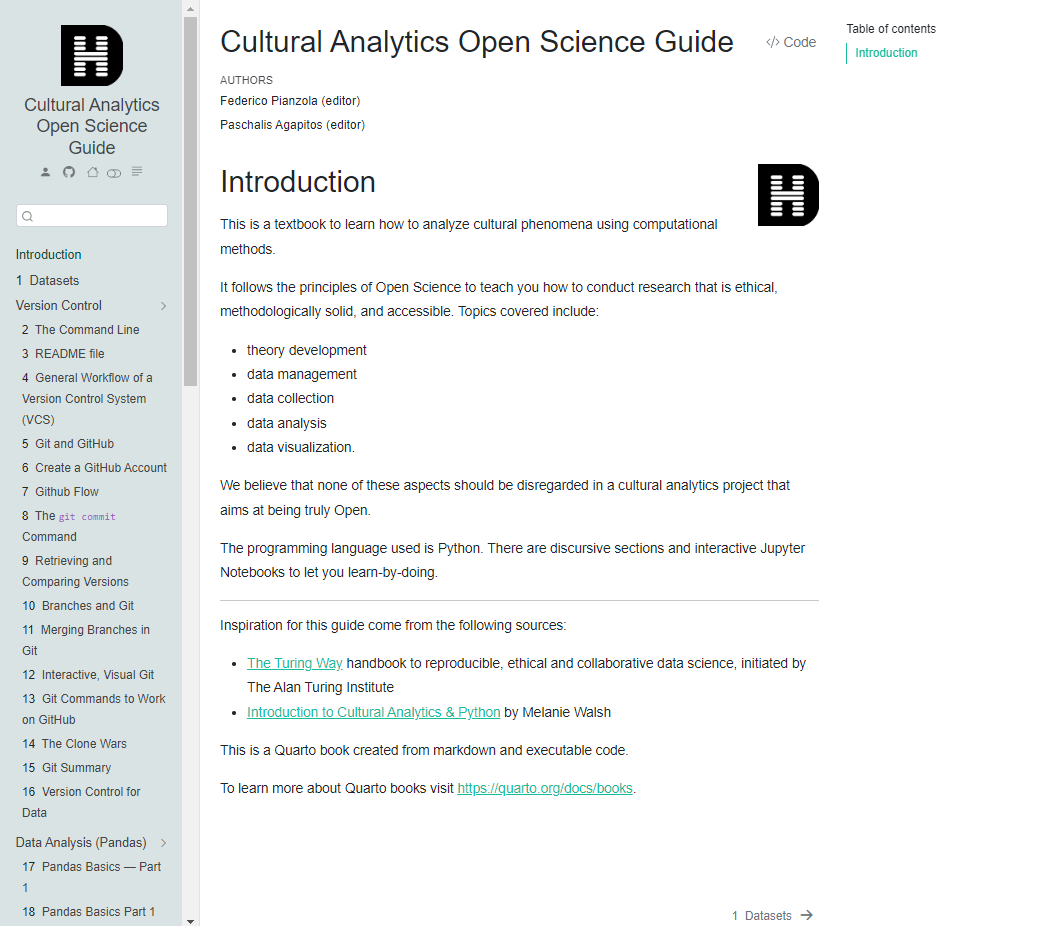OER (Open Educational Resource) textbook for and by students
This is a best practice from the Teaching & Learning Innovation project.
Sent in by: Federico Pianzola and Paschalis Agapitos

Keywords: Open Eduational Resources; Textbook; Digital Data; Data Management
Brief description
The core part of the new learning activity is the contribution of students to an online textbook, a so called OER (Open Education Resource). This OER will guide students through the materials and exercises to complete the learning track covering this course and two other courses in the Cultural Analytics learning track. Topics in the textbook are:
-
Coding for Humanities
-
Collecting data
-
Analyzing data
About the course
This is a project-based course in which students complete 3 individual assignments aimed at learning various skills related to the collection of digital data from the web, open science practices, and data management according to the FAIR principles. The final individual assessment consists in the resubmission of one substantially improved version of one of these three assignments, taking into account the feedback previously received. In this way it’s possible to evaluate if students have learned from their mistakes and became better at applying the acquired knowledge.
In parallel, students are required to prepare a final group project for which they have to formulate a research question, find data to answer the RQ, do an exploratory data analysis, and create visualizations to present the data and their exploration of it.
The instructions for the group project ask students to not only perform the required tasks but also to report on the work done in the form of a tutorial that can be used by next year’s Digital Humanities students. Students are told that if a project is of high enough quality it can be included in the OER used to teach the course in the following year. Indeed, one group’s project has been integrated into the OER
Students said they liked the approach of the textbook. They also liked the potential for the final outcome of their assignment to to be in the online textbook, to have an impact in future years. Through the project, they learned more about storing, collecting, and analysing data.
Group size
Small groups of 5-6 students.
Length of the activity
Two weeks time to prepare the first draft on which they receive feedback. Then another 2 weeks to submit the final version.
Difficulty level
[On a scale of 1-5 (1= very easy, 5 = a lot of preparation)]
4 (gathering existing material and adapting it to our needs was a quite lengthy process, but now it can be used with small adjustments even in the following years)
Preparation
-
Before class: make sure the instructions and examples are clear; find new datasets to be used
-
In class: mainly clarifying instructions and answering questions and doubts
Advantages
Since the textbook is based on the actual course, it is more suitable than existing ones.
The same approach and textbook can be used for other courses.
Challenges
The lecturers have added existing material to the textbook. Copyright issues need to be taken into account. In this case, the lecturers only used other OER’s.
How do you assess group work?
Targeted Learning outcomes
The students who master the theory and techniques given in this course will be competent cultural-analytics-textbookin gathering raw data for a typical digital humanities research question, structuring data, and annotating data for, and deciding what annotation method is most suitable for a certain task. Upon successful completion of the course unit, students will be:
(a) Competent in gathering and formatting data for a typical digital humanities research question (1.1, 2.1, 2.2);
(b) Setting up annotation guidelines (2.1, 2.2);
(c) Deciding what annotation method is most suitable for a certain task (2.1, 2.2);
(d) Critically assessing the acquired data set (2.1, 2.2).
The expectation is that by raising the quality and alignment of the online textbook, students can rely on the information presented here instead of contacting the lecturers with questions about the assignments and the tools that are used.
Students reported that the workload was slightly higher than last year. The students had to learn some technical parts of Github ( the collaboration platform on which the textbook was maintained and published), for example, which was a bit more work than previously. However, these aspects align with the learning outcomes so they are valuable.
Additional tools/material/resources
Github ( https://github.com ) - a web-based version control and collaboration platform for software developers.
The textbook can be viewed on Github: https://groningendh.github.io/Cultural-Analytics-Open-Science-Guide/
Additional information
Moving to open education: Perspectives from Chris May (Associate Professor of Psychology at University College Groningen)
| Last modified: | 31 October 2023 09.08 a.m. |
